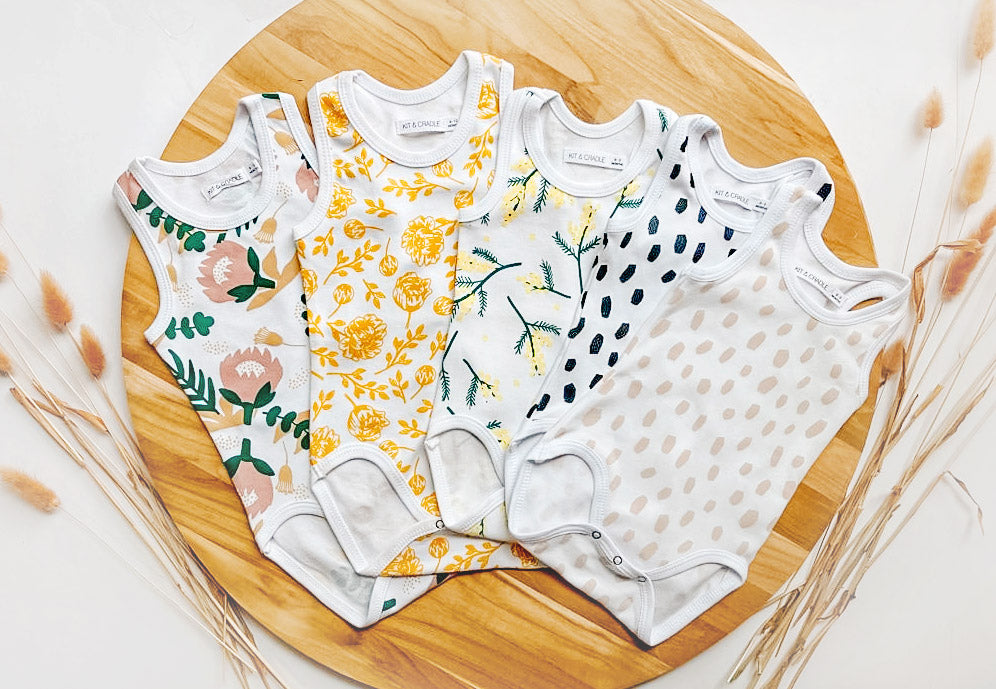
The Environmental Harm of Children’s Fashion and how we can create clothing in a less harmful way
Share
As seen on www.unsustainablemagazine.com
We all know that babies and children can have several changes of clothing a day and we all know how quickly they grow out of their clothing. So what is the environmental impact of this and what can we do about it?
The environmental harm of children’s fashion can come from a variety of sources including the use of harmful chemicals in textile production, the transportation and distribution of clothing, and the disposal of clothing that is no longer worn. In addition, fast fashion practices, which is the constant release of mass produced, low quality clothing at a very low price can contribute significantly to environmental harm by generating large amounts of textile waste, not to mention the poor labour conditions that such low pricing creates. Here are some of the ways the children’s fashion industry can harm the environment:
- Fast fashion: Many children’s fashion companies engage in fast fashion, which involves producing clothing quickly and cheaply to keep up with changing trends. These include big supermarket types such as Kmart, Target and high street brands such as H&M. This often results in poor working conditions for factory workers and a high environmental impact due to the use of synthetic materials and chemicals.
- Textile waste: Children grow quickly, and as a result, their clothing often gets worn out or outgrown before it can be worn for long. This results in a large amount of textile waste that can harm the environment.
- Chemical pollution: Many children’s clothing items are made from synthetic materials that are treated with chemicals to make them wrinkle-free, fire-resistant, or water-repellent. These chemicals can harm the environment when they are released into the air or water during production and disposal. The use of synthetic fibers, such as polyester, in children’s clothing also contributes to environmental harm, as they are not biodegradable and can release microplastics into the environment.
- Packaging waste: Children’s clothing is often sold in plastic packaging, which can contribute to plastic pollution when it is not properly disposed of.
- Transportation: The production, transportation, and disposal of children’s clothing all contribute to a large carbon footprint. The transportation and distribution of clothing contributes to greenhouse gas emissions.
It is important to consider sustainable practices and make conscious choices when purchasing children’s clothing. Here are some ways children’s clothing brands are creating clothing in a less harmful way:
- Using organic and natural materials. Using organic fabrics means there are no pesticides, chemicals and herbicides used during the growing process and therefore less toxic waste being sprayed into the environment. These practices are not only ethical, but strive for sustainability long term
- Manufacturing in smaller quantities. Brands can manufacture in smaller quantities and reduce the textile waste that will end up in landfill. This is more expensive to do as big mass brands want to manufacture in bulk for cheaper pricing and more cost efficient transportation. Support smaller brands that manufacture in smaller runs and pay their workers a living wage.
-
Local Production. Australian baby & childrens brand Kit & Cradle sources organic cotton and its whole manufacturing process is done in Australia including the screenprinting of their artist drawn patterns. It is one of a handful of brands that prints and manufactures in small production runs in Australia. Local production not only supports the local economy and workers, it reduces the carbon footprint usually required for global transportation and distribution

- Remove plastic packaging. With many alternatives to plastic packaging available nowadays, it is important that children’s clothing brands are not using plastic packaging.
- Creating higher quality clothing that can be passed on. Paying a higher price to begin with can mean more savings in the future. Instead of purchasing from cheaper, bigger brands, purchase less from a higher quality children’s brand which can mean a longer wear life.
